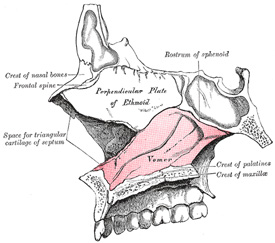| Henry Gray (1821–1865). Anatomy of the Human Body. 1918. |
| |
| 5b. 7. The Vomer |
| |
| The vomer is situated in the median plane, but its anterior portion is frequently bent to one or other side. It is thin, somewhat quadrilateral in shape, and forms the hinder and lower part of the nasal septum (Fig. 173); it has two surfaces and four borders. The surfaces (Fig. 174) are marked by small furrows for blood-vessels, and on each is the nasopalatine groove, which runs obliquely downward and forward, and lodges the nasopalatine nerve and vessels. The superior border, the thickest, presents a deep furrow, bounded on either side by a horizontal projecting ala of bone; the furrow receives the rostrum of the sphenoid, while the margins of the alæ articulate with the vaginal processes of the medial pterygoid plates of the sphenoid behind, and with the sphenoidal processes of the palatine bones in front. The inferior border articulates with the crest formed by the maxillæ and palatine bones. The anterior border is the longest and slopes downward and forward. Its upper half is fused with the perpendicular plate of the ethmoid; its lower half is grooved for the inferior margin of the septal cartilage of the nose. The posterior border is free, concave, and separates the choanæ. It is thick and bifid above, thin below. | 1 |
 |
FIG. 173– Median wall of left nasal cavity showing vomer in situ. (See enlarged image) | | |
| | | Ossification.—At an early period the septum of the nose consists of a plate of cartilage, the ethmovomerine cartilage. The postero-superior part of this cartilage is ossified to form the perpendicular plate of the ethmoid; its antero-inferior portion persists as the septal cartilage, while the vomer is ossified in the membrane covering its postero-inferior part. Two ossific centers, one on either side of the middle line, appear about the eighth week of fetal life in this part of the membrane, and hence the vomer consists primarily of two lamellæ. About the third month these unite below, and thus a deep groove is formed in which the cartilage is lodged. As growth proceeds, the union of the lamellæ extends upward and forward, and at the same time the intervening plate of cartilage undergoes absorption. By the age of puberty the lamellæ are almost completely united to form a median plate, but evidence of the bilaminar origin of the bone is seen in the everted alæ of its upper border and the groove on its anterior margin. | 2 |
 |
FIG. 174– The vomer. (See enlarged image) | | |
 |
FIG. 175– Vomer of infant. (See enlarged image) | | |
| | | Articulations.—The vomer articulates with six bones: two of the cranium, the sphenoid and ethmoid; and four of the face, the two maxillæ and the two palatine bones; it also articulates with the septal cartilage of the nose. | 3 |
|
|



